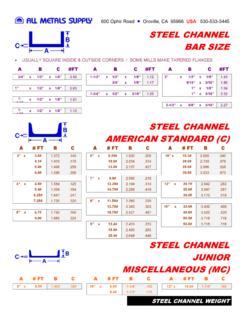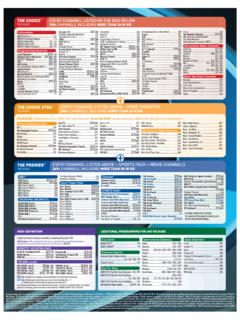Transcription of Channel Strategy & Marketing
1 For the Rest of UsChannel Strategy & Marketingby Jacqueline Guide The for challenges we face in developing indirect channels. You are not alone! Channel Strategy and Marketing ..for the Rest of UsPAGE 1Go GuideI was working for a popular software company at the dawn of the CTO gave a demonstration of the Internet to the entire company and described thrillingly what would now be possible. The auditorium was abuzz. The SVP of Sales pulled me aside afterward, with odd bravado, to let me know that the channels Marketing organization I ran would be at stake in six months. She explained with confidence that the Internet would supplant our need for business partners and all things distribution. I remember thinking Huh? What d I miss? Six months later, however, I was gainfully employed and the company s thriving indirect Channel was as critical to the business as ever. While the Internet created a new Channel and changed dramatically the way we did business, it did not supplant our business partner Strategy .
2 Instead, the Internet added to our opportunities with partners and required that we make room for new thinking and business practices. It also added to the complexity, and reinforced why indirect channels is not for the faint of heart. Put simply: A thriving Channel is a business imperative for any company that wants to scale. In fact, I m hard-pressed to name one billion dollar company that doesn t use indirect channels. Even Dell has broadened its reach to service providers to help expand its reach into the corporate market. And, Apple, with its clean, elegant online and direct store presence (is that a magnet that pulls you in when you walk by?), still uses resellers across the world to get its product to customers and provide support. Many com-panies in the B2B technology market, in particular, continue to bring home the bear with a formidable direct sales force (Oracle, EMC, etc.), but even those behemoths conceded eventually that they needed additional logistical and services capacity, especially if they wanted to reach the mid-market.
3 Indirect channels, in other words, are critical to growth and are here to stay. Channel Strategy and Marketing ..for the Rest of UsPAGE 2Go GuideSo, the point of this book is threefold: 1) To acknowledge the challenges we face in developing indirect channels (you are not alone!)2) To accelerate the learning for those confronted with these challenges (through pragmatic templates and tools) 3) To be the Go To guide for your future reference While a lot of this information is from direct experience, much is derived from a diverse base of clients. As a working e-book document, your experiences and insights are critical to its value. Please feel free to share and keep me honest, as you see fit. Organizationally, you can jump ahead as needed to the sections that follow:Nomenclature and Framework ..3 Channels ..4 Segments ..5 Partner Profiles ..8 Business Proposition ..11 Company Brand ..12 Market Opportunity ..13 Core Solution Fit ..14 Return On Investment ..18 Business Partner Program.
4 19 Requirements ..20 Benefits ..22 Recruitment ..23 Enablement/Readiness/Onboarding ..25 Loyalty ..28 Letting Go/Close ..29 About Author/R2M ..30 Channel Strategy and Marketing ..for the Rest of UsPAGE 3Go GuideFirst, the Nomenclature and Framework Raise your hand if you ve ever had this conversation at a social gathering: The first point about channels nomenclature is that you can give up the notion that you will ever find the right words to explain to your mother what you do for a living, or anyone else for that matter. Every once in awhile you will run into someone who gets it and you can enjoy the secret handshake, but for now, here s the jargon and how to put it to good use in laying your chan-nel Strategy foundation. For starters, I will define three key concepts: channels, segments and partner profiles. There s a hierarchy of nomenclature that can get confusing, so note the visual along with the term. Well-intentioned Stranger [WIS]: What is your line of work? You: Oh, I work in the channels group for [insert hot technology company here] WIS: do you do?
5 You: I find, recruit and help business partners sell our products. WIS [with head cocked like a dog]: Oh, that s interesting. Well, excuse me, my kid s Tweeting Strategy and Marketing ..for the Rest of UsPAGE 4Go GuideChannels The term channels can get confusing. Channels, more often than not, is used in the context of indirect chan-nels, meaning sales channels other than your direct sales force. Technically, though, they both represent routes to market, and should be put in context of one an-other when developing a channels Strategy . What s the difference? Direct channels are straightforward. They include the product/service provider s resources and assets dedicated to selling and supporting its product and service, otherwise known as the direct sales force, telesales, telemarketing, web site, etc. Indirect channels include business partners and routes to the customer that leverage resources and assets outside the control and not owned by the product/service provider.
6 These are commonly referred to as resellers and solution providers, but include a myriad cast of players (more on that later). Feet-on-the-Street Web ISVs Solution Providers Resellers Inside Sales Channel Strategy and Marketing ..for the Rest of UsPAGE 5Go GuideTechnically, channels should be considered a holistic term that includes both direct and indirect channels. More often than not, however, it gets reduced to meaning indirect channels. Segments First, why do we care about Channel segments? Qualifying partners into Channel segments allows you to: Channel segments define the bucket in which partners with common characteristics fall. Segments are defined most easily by the partner s business model, how they make money. We begin with how a partner makes money because if you understand that, it will be easier to construct and tailor your business proposition to the partners that fall into that segment. How technology partners make money fall typically into three broad categories: Hardware Software Services Extend and reinforce a common language across the company Accelerate the recruitment process to find partners Extend benefits to those partners cost effectivelyChannel Strategy and Marketing .
7 For the Rest of UsPAGE 6Go GuideServices can be broken out into two sub-categories as well: Professional Services (higher margin, consulting-oriented services) and Customer Services (break:fix, etc.). Let s keep it simple and focus on the three broad categories for now. At the highest level, Channel segment nomenclature often boils down to Resellers (primar-ily hardware focused) and Solution Providers (primarily software and/or services focused). As a starting point and for sake of example, you can see how the business models of these broader Channel segments differ from one another: If you understand this, you will see why one size does not fit all, in terms of what each Channel needs from you to be successful supporting and selling your offering. If it was only this easy, I d be out of business. Where it gets messy and confusing is qualifying all the business model variations and where you draw the boundaries. For instance, it s equally important to identify the profit side of the equation.
8 Software, for example, may not represent the bulk of the revenue, but may contribute a large share of the company s profits. Further, a partner Hardware 80% 10% Software 10% 40% Services 10% 50% TOTAL 100% 100% Percent of Revenue Reseller Solution ProviderChannel Strategy and Marketing ..for the Rest of UsPAGE 7Go Guidecan look like a systems integrator one day, and more like a hardware reseller another day. Sometimes, partners put software under services, or services may mean wireless band-width. While complex, the framework enables you to have a dialogue with your partners and demonstrates that you understand and care about how they make money. As mentioned, there are multitude of segments and ways to qualify channels. Some of the other segments that you hear about are listed in this table with the relative business model focus highlighted. This table is provided as an example and not intended to represent the absolute picture.
9 Application Service Providers (ASP)ConsultantsCorporate ResellersDirect MarketerseTailers Hardware IntegratorsIndependent Software Vendors (ISV)Managed Service Providers (MSP)Network IntegratorsRetailService providersSoftware as a Service (SaaS)Software Developers/Providers (Horizontal, Vertical, Custom)System Integrators (Regional, Global/GSI, Federal)Wireless CarriersChannel SegmentHardware Software ServicesPrimarySecondaryWhat s important in building your channels model is what is relevant to you and your partners, then exercising the necessary amount of flexibility for exceptions. Little/No PresenceChannel Strategy and Marketing ..for the Rest of UsPAGE 8Go GuidePartner Profiles Profiling partners within each segment allows you to do a few things better: Within Channel segments, while partners look similarly based on business model, individual partners within that segment may vary dramatically, based on: Target market (enterprise, mid-market, small-medium business [SMB]) Vertical market expertise (health care, education, government, etc.)
10 Geographic presence/reach ( ) Core competencies & solution differentiation Routes to market & distribution Strategy Vendor relationships Revenue/size Whether you outsource the recruitment effort, or have your channels organization take on the task, a partner profile will help you qualify fit between your respective companies. Manage your partners as a portfolio enabling you to minimize duplication of resources and manage your risk Create guidelines for sales and Marketing in recruiting the right partners Fine-tune your business proposition to the partner level Channel Strategy and Marketing ..for the Rest of UsPAGE 9Go GuideHere is a sample partner profile template to tailor for your own use: SAMPLE PARTNER PROFILEP rofile CategoryCharacteristicsFill-in-the-Blank Revenue, # of employees Emerging, established Local, regional, global Percent of revenue and/or profit driven by hardware, software, services Customer service, professional services, etc.







